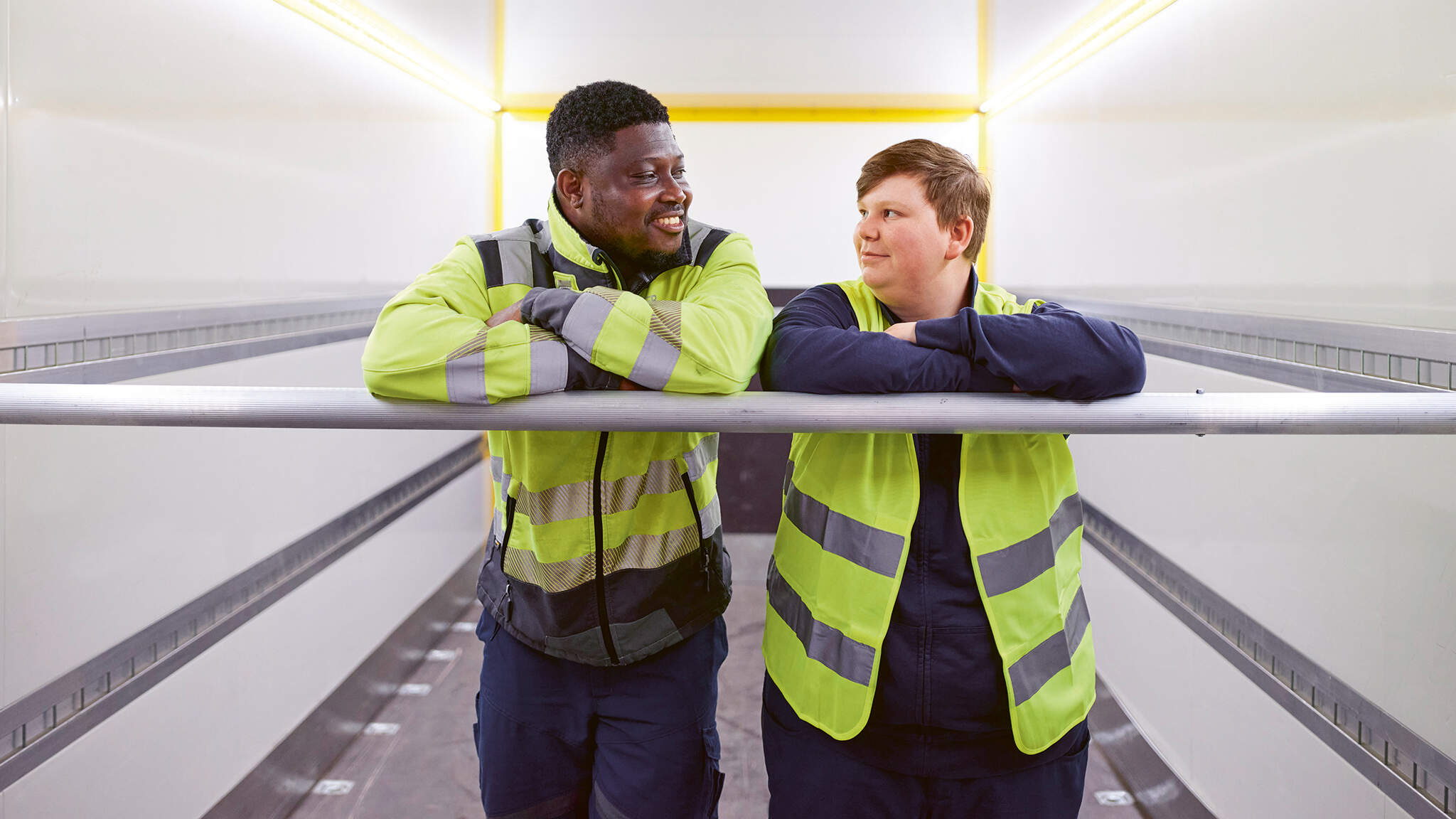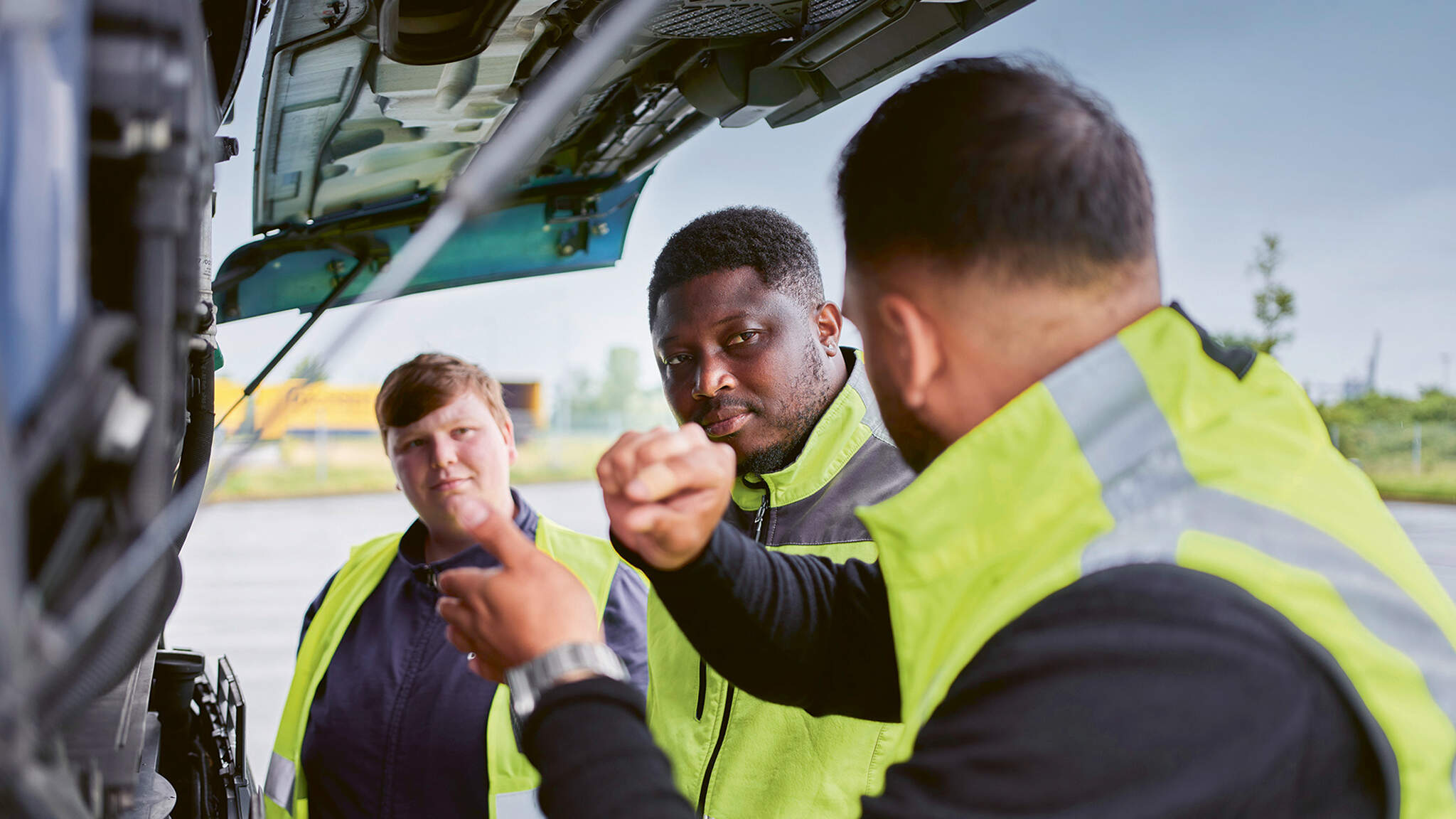The next generation at the wheel
The logistics industry doesn’t have enough young drivers. What it needs are appealing training concepts. For ten years, DACHSER Service und Ausbildungs GmbH has been setting standards in the training of drivers in the logistics sector. The Bremen branch was part of this endeavor from the very beginning.

It may be “just” a truck, but the new arrival at DACHSER’s Bremen logistics center on Senator-Blase-Strasse has already achieved the status of a “silent star” after only a few weeks. “Silent,” because the 16-ton battery-electric truck from Renault glides almost noiselessly through traffic in and around Bremen, with zero local emissions, making it a quiet and environmentally friendly transport solution. And it’s a “star” for the drivers as well as for the recipients and passers-by. “It’s the lower noise level in particular that many people notice immediately. And our e-truck is also very maneuverable, making it ideal for city centers,” says Michael Schrader, General Manager European Logistics DACHSER Bremen, who’s delighted with the newcomer at his branch.
“Intelligent technology is one thing,” says Schrader, “but the people who operate it are at least as important. A high-tech vehicle also needs quality in the driver’s cab and at the wheel.” But this is precisely where a structural problem has been emerging for some time: the freight forwarding industry is running out of young drivers. According to a study by the International Road Transport Union (IRU), as many as 62 percent of carriers in Europe complain that they are having major problems recruiting people to drive their trucks. Germany alone already has a shortage of 70,000 skilled workers, with jobs at the wheel going unfilled at a rate of some 20,000 per year.
Training that sets a precedent
DACHSER takes up this challenge: in 2014, it launched its own qualification offensive by founding DACHSER Service und Ausbildungs GmbH. The aim is to attract young people to the driving profession, inspire them, train them, and secure them for the market over the long term—perhaps with them later becoming independent transport subcontractors themselves.
In Bremen, the concept fell on fertile ground right from the start. Schrader played an active role on the steering committee in setting up and developing the training organization. He then placed the practical implementation at the Bremen site in the hands of his fleet manager, 40-year-old family man Christopher Trettin. “In 2015, we were able to recruit just one apprentice. Later on, there were three, but none of them made it through the whole program,” Trettin reports. The dropout rate in professional driver training has always been high, often over 50 percent. “But we didn’t get discouraged. We kept going and continued to work on ourselves. At some point, word got around that the quality and content of training at DACHSER is very good, and today, we have between six and twelve trainees across all three years of the program."
Every year, around 100 trainees in Germany begin their training as professional drivers at the DACHSER branches. Within ten years, it’s become one of the leading education and training companies for professional drivers in Germany. “We professionalized the provision of TQ1 truck driver training and took a careful look at all processes relating to the world of drivers,” says Alexander Tonn, COO Road Logistics at DACHSER.
“It’s crucial not only to find good drivers, but also to retain and motivate them over the long term,” says Hendrik Jansen, Managing Director of DACHSER Service und Ausbildungs GmbH. The fact that people’s attitudes to work have changed should also be taken into account. Nowadays, topics such as work-life balance, changing communication, and rewarding, meaningful work play an important role.

A culture that creates cohesion
Torsten Heiber remembers starting his driver training in Bremen as a young man back in 2015. His excellent progress delighted his fleet manager, but at some point, he decided to pursue a different career option and dropped out of training. However, he returned to DACHSER in 2018, completed his training with flying colors in 2020, and worked for a while as a task force driver. This is a standby service that DACHSER offers to support its service partners. Torsten is now 26 years old, has matured both professionally and personally, and has moved into fleet management. Alongside Trettin, he puts his heart and soul into looking after the driver trainees at the Bremen branch. “It was a real stroke of luck for us to recruit Torsten for the training program. He’s familiar with the demands of training and day-to-day driving, and from his own experience, he knows all about the prejudices and seemingly attractive temptations that can stand in the way of a driving career,” Trettin says. “We and our trainees really appreciate that.”
One of these trainees is Henrike Eisleb. Now in her second year of training, the 20-year-old aspiring professional driver is already a valued member of the Bremen team. That’s not a given: women drivers are still rare, with an industry average of just 2 percent. Trettin believes one reason more women don’t become drivers is the image of them as “kings of the highway”; i.e., still a very male-dominated group. Another is that the task is considered physically demanding. “Naturally, you sometimes have to get physically involved when on a tour; for example, when it comes to extending a swap body’s supports after maneuvering it into place,” Trettin explains. However, there are now many ergonomic aids that support the lifting of heavy loads, as well as electric pallet trucks that make it much easier to move and stow pallets. “The idea that none of this is possible for women is plainly a myth. Eisleb is doing a great job in her training, and we’ve had nothing but the best experiences with our women drivers.”
A demanding profession
In general, professional drivers today need more brains than brawn; for example, when it comes to making optimum use of the equipment.
“Our trainees often get to drive the electric vans and e-trucks used in short- and long-distance transport,” Jansen says. “They’re curious and fascinated by new technology. As ‘first movers,’ they receive self-confidence as well as the certainty that they’re on the right path for the future.” In Bremen, one of the vehicles the third-year trainees are allowed to drive is the brand-new all-electric E-Tech D16 from Renault Trucks. “Eisleb is already looking forward to it. Being entrusted with state-of-the-art technology always gives our trainees a bit of pride,” Trettin says.
And rightly so, since these prospective drivers are entering a demanding field. Legal and administrative know-how is no less important than the technical and driving skills; for example, with regard to road traffic regulations, dangerous goods, or securing cargo. “All this calls for a certain kind of personality,” Trettin says. “Professional drivers aren’t auxiliary staff, but skilled workers who are willing and able to take responsibility for the vehicle and the goods they’re transporting. With an average of 16 stops and 16 separate points of contact, they also meet a wide variety of people, all of whom have different moods and attitudes. So they have to have presence and personality.”

Setting new training standards
With a view to the critical role of professional drivers and with all the experience gained from ten years of training, the agenda of DACHSER Service und Ausbildungs GmbH is clear: “In an increasingly challenging labor market, it’s more important than ever to work together as equals in a spirit of trust, provide attractive working conditions for drivers, and ensure strong and sustainable cooperation with our service partners,” Tonn says.
This year, the Road Logistics business field launched another initiative dedicated to continuing the fair and respectful cooperation with transportation companies. Its starting point is a Service Partner Code of Conduct, which is intended to serve as a uniform cultural guideline for collaboration.
All these concepts and measures aren’t enough to solve the structural and global shortage of drivers, but they at least set the course. “Sustainable logistics will be determined by quality—of both the service and the people who provide it on a daily basis,” Tonn says. “The decisive foundations for this are laid in education and training.” And then it’s not only the latest generation of vehicles that are the stars, as in Bremen, but the drivers, too.
